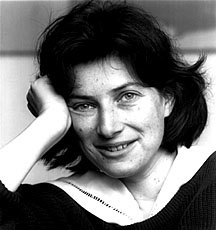History with a Small h
John Haberin New York City
Chantal Akerman: Bordering on Fiction
A Jewish Museum has, almost by definition, a momentous history. The one in New York has had a long record of bouncing back and forth—between cutting-edge art and Jewish cultural history. Now it can fairly claim to encompass both. Chantal Akerman, a Parisian whose large, influential body of work includes film and video, is exhibiting a film of her recent travels in Eastern Europe. 
It would be wrong to say that she is out to freeze this moment in history. Rather, she shows it thawing very, very slowly. In her new installation, called "Bordering on Fiction," she helps us understand what it means when a moment in history is the present.
D'Est ("From the East") is about people, like Eastern Europe's "Ostalgie" or the work of Paweł Althamer, with the same closeness to the individual life that another Frenchwoman, Sophie Calle, turns on herself. It sets a model for any number of confessional artists and feminists ever since, such as Jana Leo. Its seventy scenes, with little more than ambient sound, show them trying to keep their lives going—trudging, driving, carrying, and above all waiting. Sometimes they pursue pleasure. One sees them wrapped up in dancing, television, or makeup—but always with the slow pace and unfocused air of necessity.
Where they are walking in this inhuman winter landscape, and what longing or expectation has made them so fixedly to wait? Rarely does the camera let us know. Akerman has said that she is drawn to faces in all their diversity. In that moment, they detach themselves from the crowd. As the camera again moves on, they lie briefly in the film's world, between anonymity and individuality. One can see their artistic influence even in Lorna Simpson's representations of the black urban experience.
They also lie somewhere between a Communist past and an unknown future. History can evoke a sense of loss, as old worlds pass away, or promise. The riddle, I know, is always greater still for Jews, shown in several scenes. For a Jew in Europe, like Man Ray in Paris, the very link to the past must come with a struggle against hatred and authority. Akerman, whose Jewish parents came to Belgium ultimately from Poland, says that she did not go in search of her roots, because what one seeks is too limiting: one tends to find it. But the riddle of the present suffuses these scenes, which flow from Germany into Russia.
The present was always the implied tense of avant-garde film anyway, ever since Jonas Mekas with his "glimpses" or Andy Warhol and Michael Snow, and their vocabulary of long, rolling pans and lingering, hand-held, near-empty shots has long been hers, too. The 107-minute movie runs continually, so that people come and go as one sits, emphasizing even further the immediate passing of time. Perhaps unfairly to Akerman, I was left with little concern for a larger unfolding, the film's structure, as I ducked in and out myself.
I was off to catch the adjacent room, where twenty-four monitors hold scenes from the movie, plus an alcove where Akerman recites in English her "script" for the film, really a brief statement of purpose. She begins in Hebrew, however, as if asking the Bible whether Judaism holds anything for her now. She could have been speaking for me as a secular Jew, for Jewish artists of the past and present, for contemporary artists encountering Jewish tradition and Jewish antiquities and women questioning other canons. She could have been challenging art to have as genuine ties to the world as text. She is reading a passage with special questions for a visual artist, the commandment against the worship of images.
Those very words echo upstairs, too, in some uncharacteristically calligraphic paintings by Morris Louis, the great color-field painter. As I stood, I wondered if they had rebelled against that commandment or accepted it—with all the gamble of reinventing Western art's heritage. Or perhaps, like that awesome injunction, she only brings humankind's most feared events down to earth. In her film, she restores to history the small h.

"Bordering on Fiction: Chantal Akerman" ran through May 27, 1997, at The Jewish Museum in New York. Her faculty page at the European Graduate School has much useful background.




